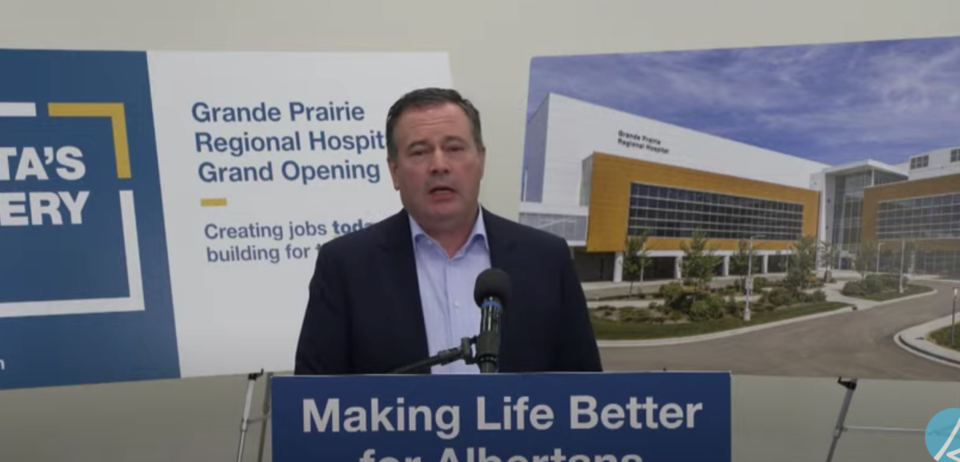Based on the continuing decline of COVID-19 cases and hospitalizations, Premier Jason Kenney announced Feb. 26 the province will move forward into step two of phasing out COVID-19-related restrictions.
During a press conference to mark the grand opening of the new hospital in Grande Prairie Kenney provided a COVID-19 update.
“I am very pleased to announce that with promising trends, we are in a position to safely move to step two of our path back to normal, and remove the vast majority of remaining public health measures in Alberta,” Kenney said.
As of 11:59 p.m. on Feb. 28, the mask mandate will be removed, but masks will still be required in high risk settings like public transit, Alberta Health Services operated facilities, and continuing care settings.
All capacity limits for venues will be removed, restrictions on interactive activities, liquor service and operating hours for hospitality will be lifted, all social gathering limits will be removed, any remaining school requirements will end, as well as health screening for youth activities.
The mandatory work from home order will be lifted, which Kenney said was great news for the downtown core of Alberta’s main cities.
“I know some may greet the lifting of restrictions with mixed emotions, but I want to remind you, Alberta is not alone, in fact, places around the world and across Canada have begun their transition to the endemic state and have lifted measures as their Omicron waves subside,” Kenney said.
He added the lifting of restrictions across the world has not resulted in an increase of COVID-19 cases.
Kenney urged Albertans to be patient with each other and respect those that choose to continue wearing a mask based on their own health risk assessments.
He added that the path forward continues to include vaccines and said booster shots to avoid any future COVID-19 wave.
“I am pleased to see that the stress on our health-care system continues to lessen. Not only does this allow us to ease more public health measures, it also reduces the pressure and strain on our dedicated health-care workers who have worked tirelessly through the pandemic to provide expert care to Albertans," said Jason Copping, Alberta’s minister of health.
According to Kenney, all signs in Alberta and across the world suggest that the worst of COVID-19 is past.
When the provincial government announced step one of their “path back to normal” on Feb. 8, there were 1,615 Albertans in hospital with COVID-19, compared to less than 1,300 COVID-19 hospitalizations on Feb. 25. That is a 20 per cent decline in under three weeks, Kenney said.
A further reduction was seen in Alberta’s Intensive Care Units (ICU) with 88 current COVID-19 admissions, equating to a 34 per cent decrease since Feb. 8.
Alberta’s seven-day average of total hospitalizations of 1,435 is down from an average of over 1,600 from Feb. 14, Kenney noted. The seven-day average for ICU occupancy has decreased significantly to 103 from 126 on Feb. 14.
“The best news when it comes to our hospitals is that overall our rate of new hospitalizations due to COVID-19 has dropped significantly over the last month. In addition to declining numbers in our hospitals, our daily cases, which is more of a leading indicator, continue to decline quickly,” Kenney said.
On Feb. 25, an increase of 600 cases was reported, which is down from a peak of 6,800 on Jan. 11, which is a 90 per cent decline in daily new cases, Kenney noted.
Due to testing changes, the number of cases isn’t the best metric, he explained, but it’s still an encouraging sign. The positivity rate of tests has also declined, with a current seven day average of 22.9 per cent compared to 29 per cent ten days earlier.
“When considering all this information as a whole, there is no evidence at this point to suggest that our transition to normal is negatively affecting our health care system,” Kenney said.
He added all positive trends continued after schools returned to in-class learning in early January, and after masking for students in school and the restriction exemption program (REP) was lifted on Feb. 8.
“We needed to do this carefully and prudently. We didn’t want to rush into it, and we needed to take this one step at a time to be sure that our relaxation of these difficult public health measures did not push us back into an uptick of viral transmission or hospitalizations,” Kenney said. “Three weeks later, we can say with confidence that the numbers continue to decline rapidly despite important measures we took three weeks ago to open up.”
He said time and again Alberta’s healthcare system has been stretched to its very limits with workers who are physically and mentally exhausted and facilities constantly adjusting their spaces to accommodate more patients.
“It seems fitting we’re here at a hospital talking about COVID-19 where so many individual battles against the disease have been fought,” Kenney said.
He noted the new Grand Prairie hospital saw its first patients in December, but Feb. 26 marked the official grand opening of what he said is Alberta’s most modern and technologically-advanced hospital.



